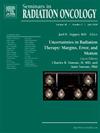推进前列腺癌治疗:CT和mr引导的在线适应性放疗技术综述
IF 3.2
3区 医学
Q3 ONCOLOGY
引用次数: 0
摘要
放射治疗仍然是前列腺癌(PCa)治疗的基石,随着技术的不断进步,放射治疗的准确性大大提高,治疗相关的毒性也大大降低。在这些创新中,适应性放疗(ART)通过先进的成像、实时运动跟踪和桌上适应性规划提高治疗精度,正在彻底改变该领域。抗逆转录病毒治疗具有优化治疗结果的潜力,可以根据以前无法解释的解剖变化调整辐射剂量,从而最大限度地减少对健康组织的损害,并增加对治疗目标的剂量递送。磁共振(MR)和计算机断层扫描(CT)成像通过为治疗计划和实时指导提供详细的解剖和功能见解,在抗逆转录病毒治疗中发挥了关键作用。本文综述了ART治疗前列腺癌的技术原理、临床应用和最新技术进展。它描述了离线和在线ART工作流程,并比较了ct引导和mr引导的方法,概述了每种方式如何通过改进的可视化、自动分割和计划适应能力来提高辐射输送的精度。随着ART技术的不断发展,这些成像引导的方式可以通过更安全的剂量递增、最小化毒性并最终改善患者的预后来改进前列腺RT。本文章由计算机程序翻译,如有差异,请以英文原文为准。
Advancing Prostate Cancer Treatment: A Review of CT and MR-Guided Online Adaptive Radiotherapy Techniques
Radiotherapy remains a cornerstone in the management of prostate cancer (PCa) with continuous technological advancements significantly improving precision and reducing treatment-related toxicity. Among these innovations, adaptive radiotherapy (ART) is revolutionizing the field by enhancing treatment precision through advanced imaging, real-time motion tracking, and on-table adaptive planning. ART carries the potential to optimize therapeutic outcomes by adjusting radiation dose in response to anatomical changes that previously could not be accounted for, thus minimizing damage to healthy tissue and increasing the delivery of dose to therapeutic targets. Magnetic resonance (MR) and computed tomography (CT) imaging have played pivotal roles in ART by providing detailed anatomical and functional insights for treatment planning and realtime guidance. This review explores the technical principles, clinical applications, and recent technological developments of ART in the management of PCa. It describes both offline and online ART workflows and compares CT-guided and MR-guided approaches, outlining how each modality enhances the precision of radiation delivery through improved visualization, auto-segmentation, and plan adaptation capabilities. As ART technologies continue to evolve, these imaging-guided modalities are poised to refine prostate RT by enabling safer dose escalation, minimized toxicity, and ultimately, improved patient outcomes.
求助全文
通过发布文献求助,成功后即可免费获取论文全文。
去求助
来源期刊
CiteScore
5.80
自引率
0.00%
发文量
48
审稿时长
>12 weeks
期刊介绍:
Each issue of Seminars in Radiation Oncology is compiled by a guest editor to address a specific topic in the specialty, presenting definitive information on areas of rapid change and development. A significant number of articles report new scientific information. Topics covered include tumor biology, diagnosis, medical and surgical management of the patient, and new technologies.

 求助内容:
求助内容: 应助结果提醒方式:
应助结果提醒方式:


